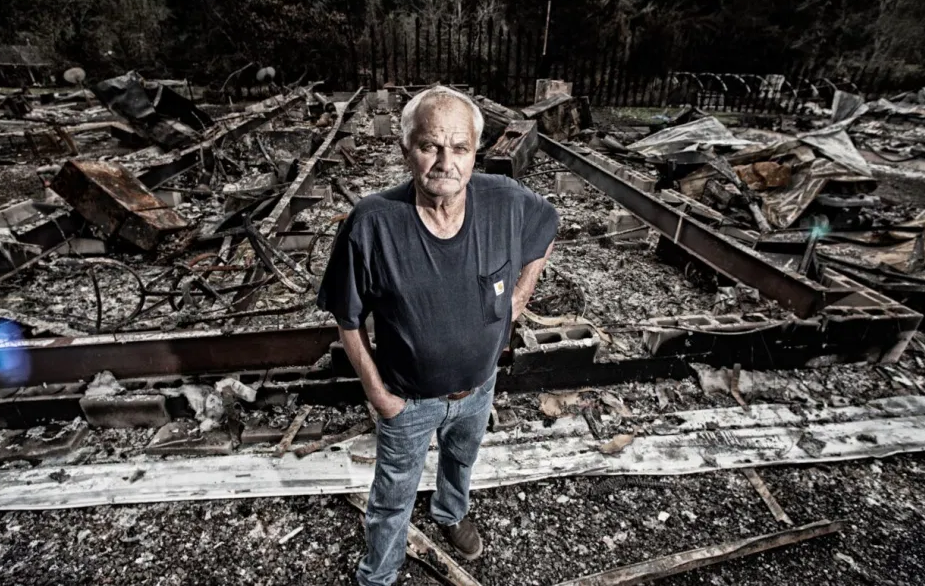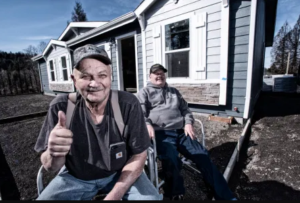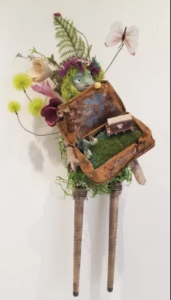
By LORI TOBIAS/Oregon Arts Watch
Photographer Bruce MacGregor waited out wildfire evacuation warnings near his home in Clackamas County for weeks last fall before it felt safe to head to Otis. There, in the tiny town along Oregon Highway 18, he met survivors of the devastating Labor Day wildfire. He didn’t expect anyone to agree to his request for photos, but their responses were a surprise.
Those photos are part of the new Up from the Ashes exhibit in the Lincoln City Cultural Center’s PJ Chessman Gallery that runs through May 9.
“It’s a pretty special show,” said Krista Eddy, gallery director. “We are trying to share people’s stories and also show that there is this amazing spark of hope and resilience in people. They’ve struggled and there are good things at the end.”
The exhibit includes objects pulled from the rubble following the Echo Mountain Complex Fire, which burned 2,500 acres and destroyed 300 homes, as well as artwork created by community members, and MacGregor’s photos, which were made before he knew of the planned exhibit, and found a home in it after.
“I had become interested in the project and had put out to relatives and friends that if they knew anyone, I would be happy to do some photography, if it would be useful,” MacGregor said. “I got back one request for a GoFundMe site. He was trying to raise money and wanted photography of himself and his wife. That was the first and most poignant.”

In Otis, a town of about 3,500 a few miles east of Lincoln City, MacGregor met Saki and Guy (Eddy has requested last names not be used, out of respect for fire victims’ privacy), the couple who started the GoFundMe site, and their neighbors, including Larry.
“Many of the neighbors met the first time that day,” MacGregor said. “They were there, shellshocked. It was the first time or the first week they were allowed back in. Without exception, everyone let me photograph them.” The reason, he said: “Just a desire to talk. If I provided an opportunity to listen, it didn’t matter that there was a photograph. They wanted the story to come out.”
They talked about the night of the evacuation, of the order to go that came at about 1 a.m. and often with only five minutes to act. They talked of how they’d prepared for the possibility of an evacuation — who would drive, what they’d take, which was the safest way to go. They talked about what they’d lost and what they’d found.
“Larry had been back visiting his home … He found his property had been looted, property taken,” MacGregor said. “That was the story I hated hearing. I met a group of four that lived real close together on Yodel Lane, a mobile-home neighborhood by the Salmon River. These neighbors had been getting together … We did a group shot. It was a most memorable day, a most memorable group — a small brave group.”
Other survivors brought finds from the rubble and ashes to the Cultural Center: melted metal, figurines, keys, and items whose original purpose was not readily identifiable. Arlene and Lyle Gowing, textile artists who have shown at the gallery, brought a clam gun that had been transformed by the heat into what Eddy describes as a wiggly, organic silver shape. “After losing everything, they were just really inspired by this item that was found in this new beautiful shape,” Eddy said.
A stained-glass maker whose house – and its dozen stained glass windows – was destroyed, “brought in this big chunk of glass of all different colors that fused together. It’s like a rock. It’s pretty extraordinary…”

And there are the dolls — not traditional dolls, but dolls crafted from art kits and meant to hang on a wall. The kits, put together by Suzan Sachdeva, who also creates the art kits handed out to kids at the Cultural Center, came with instructions, hardware, and hinged pieces of wood. Forty-five of them were distributed at the Otis Grange. About 20 are on display in the exhibit.
“It’s a healing process…working through the pain,” Eddy said. Artist Maggie Anderson, who creates miniatures for a living, found a “special treasure box” made of metal, which was rusted and warped after the fire.
Anderson created a doll to hold the box, using natural elements including leaves, flowers, and moss.
“It looks like a little forest sprite holding this box,” Eddy said. “Inside this box, she made a miniature of a grassy meadow, pine trees, and a little cabin. Maybe it’s imaginative of what her new home may look like.”
— Lori Tobias of Newport is a freelance writer, author and regular contributor to Oregon ArtsWatch. This story is supported in part by a grant from the Oregon Cultural Trust, investing in Oregon’s arts, humanities and heritage, and the Lincoln County Cultural Coalition. For more arts news coverage go to Oregon ArtsWatch.


